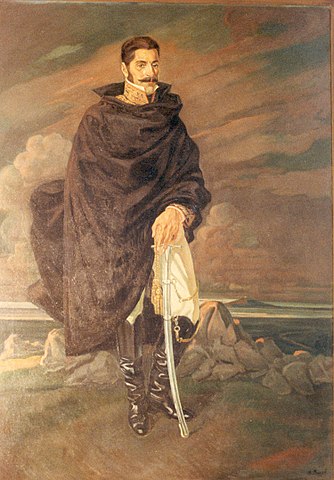________________________________________
THE URUGUAYAN CIVIL WAR, PART ONE
(1839-1848)
________________________________________

An illustration of Montevideo's defenses during the Great Siege of Montevideo.
Uruguay's role in much of the 19th Century seemed to be as South America's battlefield. First annexed by the Empire of Brazil in 1821, it was with Argentine assistance that the Thirty-Three Orientals overthrew the Brazilian regime in the Cisplatine War. This newfound independence was immediately shaken by the loss of the Thirty-Three candidate in the nation's first presidential election. Instead, Fructuoso Rivera, who had served under the Argentinians, was elected. This would set the nation on a course from which it would face great difficulty recovering.THE URUGUAYAN CIVIL WAR, PART ONE
(1839-1848)
________________________________________

An illustration of Montevideo's defenses during the Great Siege of Montevideo.

Fructuoso Rivera, First President of the Oriental Republic and Leader of the Colorados
The election of Rivera had triggered revolts in military organizations which had served under General Juan Lavalleja, Rivera's primary competitor for influence in the fledgling Oriental Republic. In turn, President Rivera's supporters, with the support of Argentine Unitarians, began to attack Lavalleja's men, and the nation plunged into what would only be a minor precursor to the later Civil War. While the conflict ended after only one battle, General Lavalleja was still forced to flee into Argentina, where he was offered refuge by Federalists.

General Juan Antonio Lavalleja
Stability was only briefly interrupted by another failed attempt by Lavalleja to invade Uruguay. Beyond this, things would remain quiet in the Oriental Republic until Rivera's succession by Manuel Oribe, another member of the Thirty-Three Orientals. While Oribe was initially Rivera's choice to succeed him, it became increasingly clear to the incumbent president that Oribe possessed discomforting ties with Lavalleja, and after ascending to the presidency, removed Rivera from office and granted amnesty to Lavalleja.

Manuel Oribe, Second President of the Oriental Republic and Leader of the Blancos
This decision would prompt Rivera to launch a rebellion against Oribe's government. It was at this time that Oribe ordered his supporters to wear white armbands - hence Blancos. In response, Rivera initially urged his men to wear blue, but due to the impermanence of the dye, switched to red. Rivera's supporters were henceforth known as Colorados, and represented mostly the interests of urban residents of Montevideo, the nation's capital.

Armbands worn by Blancos and Colorados in the Uruguayan Civil War.
Argentina, which neighbored Uruguay, saw in the fledgling nation a reflection of itself, as it was also facing internal tensions. This, coupled with Juan Manuel de Rosas' support for Lavalleja's cause, led the Federalists to first cross the River Uruguay. Before long, Unitarians under Juan Lavalle, De Rosas' primary rival, had entered the Oriental Republic with the goal of securing a position of power for the Colorados that they could use to launch a counterattack against their Argentine Federalist enemies.
The Uruguayan Civil War had become a proxy war for the Argentine Confederacy's enemy factions.
The war, however, was initially a success for the Blancos, who had a base of support in the Uruguayan countryside and urban areas outside of Montevideo. In the Battle of Arroyo Grande, Oribe's forces secured a sound victory, taking less than 1/10th of the casualties felt by the Colorado army. Rivera was forced to quickly retreat to Montevideo, where he set up defensive fortifications and prepared for a long siege. And a long siege it was.

The Battle of Arroyo Grande, with Argentine flags shown.
Although the siege had been started in 1843, it had dragged on to 1848, partially buoyed by French and British supplies and troops. This arrangement, however, would not last, as the Arana-Palmerston-Bastide Treaty had resulted in both an end to the blockade against Argentina and the recognition of Manuel Oribe as the legitimate president of Uruguay. It is in 1848, as the Colorados face a potential loss of support from Europe, that the Oriental Republic stands on the precipice of concluding its nearly decade-long civil war.
Last edited:












